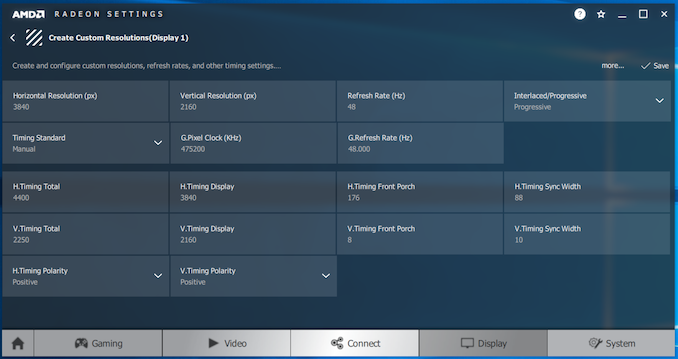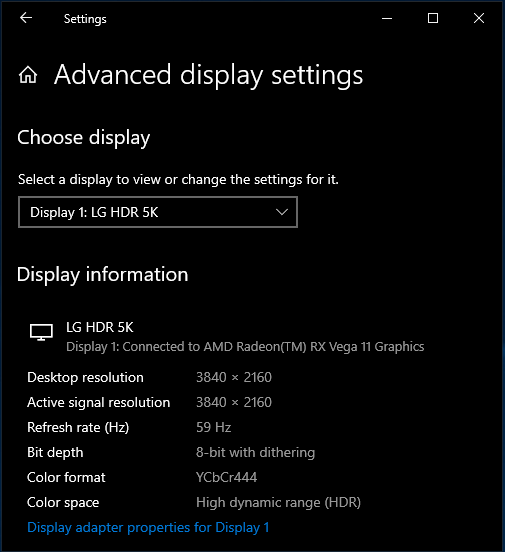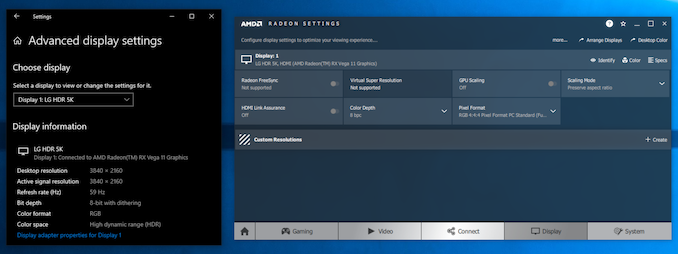The ASRock DeskMini A300 Review: An Affordable DIY AMD Ryzen mini-PC
by Ganesh T S on April 26, 2019 8:00 AM ESTHTPC Credentials - Display Outputs Capabilities
The
| ASRock DeskMini A300 Display Outputs | |||
| HDMI | DisplayPort | VGA | |
| Version | 2.0a | 1.2 | N/A |
| Max. Video Output | 3840x2160 @ 60Hz | 4096x2160 @ 60Hz | 2048x1536 @ N/A |
| HDCP | Yes (2.2) | N/A | |
| HDR | Yes | No | No |
| HD Audio Bitstreaming | Yes | N/A | |
Supporting the display of high-resolution protected video content is a requirement for even a casual HTPC user. In addition, HTPC enthusiasts also want their systems to support refresh rates that either match or be an integral multiple of the frame rate of the video being displayed. Most displays / AVRs are able to transmit the supported refresh rates to the PC using the EDID metadata. In some cases, the desired refresh rate might be missing in the list of supported modes.
Custom Resolutions
Our evaluation of the
We tested out various display refresh rates ranging from 23.976 Hz to 59.94 Hz. Of particular interest is the 23.976 Hz (23p) setting.
The gallery below presents screenshots from the other refresh rates that were tested. The system has no trouble maintaining a fairly accurate refresh rate throughout the duration of the video playback.
High Dynamic Range (HDR) Support
The ability of the system to support HDR output is brought out in the first line of the madVR OSD in the above pictures. The display / desktop was configured to be in HDR mode prior to the gathering of the above screenshots.
By default, the DeskMini A300 drives a YCbCr 4:4:4 signal to the display in HDR mode. This is in contrast to the sub-samped (4:2:2 or 4:2:0) formats used by other GPUs. 4:4:4 ensures that the desktop doesn't have any chroma sub-sampling artifacts leading to fuzzy display of text content. The Readeon Settings application allows for easy configuration of any desired pixel format. We were also able to configure a RGB 4:4:4 full level signal (0-255) in the HDR mode.
AMD systems do not support the Software Guard Extensions (SGX) feature needed to play back UHD Blu-rays. Hence, we didn't bother running the CyberLink UHD Blu-ray Advisor Tool in the DeskMini A300.




















88 Comments
View All Comments
kaidenshi - Saturday, April 27, 2019 - link
We get by with Emby Server on a Dell PowerEdge tower server, and a Roku Ultra for the TV. It's not as ideal as having it all in one box, but it allows for more flexibility in storage as well as media sources (besides Emby, the Roku has hundreds of streaming channels). In the past we used a Mac mini but it was simply too limited in storage options.b4cks14sh - Tuesday, May 28, 2019 - link
I was a long time WMC user myself. Once you get into Kodi + Tvheadend you will never look back to WMC. LibreELEC is a great Linux Distro for Kodi. Just try it!Rontalk - Monday, July 15, 2019 - link
It better can Run Windows 7, because I want that too. Did you try to mod driver?PeachNCream - Friday, April 26, 2019 - link
Seems like a nice little box. I'm not a fan of the design. The front of the case is downright unappealing, but for the price point its hitting, that's at best a minor detraction. Who looks at their PC anyhow?Arnulf - Saturday, April 27, 2019 - link
Kidz do.Alexvrb - Saturday, April 27, 2019 - link
I think it looks OK for an office-type PC. If I hadn't already built my dad an ITX 2200G cube last year, I would probably buy this. It would get tucked out of sight anyway. $150 for the chassis, board, 120W brick PSU? Not bad, especially given it doesn't exactly have a craptop of AM4 competition - at least not at present.The 3200G/3400G APUs are basically tweaked Zen+ models. Although, that's not a bad thing if you're building one of these SFF PCs... rumors are a couple hundred more MHz, better GPU clocks, overclocks better, and lower TDP (at least at stock settings).
PyroHoltz - Friday, April 26, 2019 - link
How much power is the usb-c port capable of delivering via the PD protocol?notashill - Friday, April 26, 2019 - link
The manual doesn't indicate support for USB-PD at all, so it's probably just the base USB-C spec 5V 1.5A.Alexvrb - Saturday, April 27, 2019 - link
Welcome to USB-C, the standard that comes with almost nothing standard and almost everything you can think of optional. :P Could be anything, but I suspect notashill is right.VirtualLarry - Friday, April 26, 2019 - link
If they have PCI-E x4 available for a LAN MAC/PHY, and they're only using x1 on a cheapo RealTek, why not give us a "A300 Premium" edition, with an x4 10GbE (like their TaiChi Ultimate board), or at the very least, a 2.5GbE (using the newest RealTek NICs), like their Intel Phantom Gaming boards.Realistically, these A300 DeskMini units are going to be in use for quite some time (and no way to plug in an expansion NIC*), and the time is ripe, for us to get better than 1GbE NICs these days.
(*) Club3D has announced USB3.0/3.1 Gen1 external NICs, with RealTek 2.5GbE chips inside them. I also await them, I suppose one could sacrifice a USB3 port on the A300 for one of those.